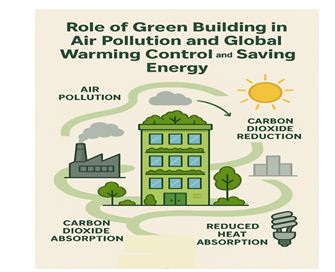Volume 10, Issue 3 (September 2025)
J Environ Health Sustain Dev 2025, 10(3): 2709-2711 |
Back to browse issues page
Download citation:
BibTeX | RIS | EndNote | Medlars | ProCite | Reference Manager | RefWorks
Send citation to:



BibTeX | RIS | EndNote | Medlars | ProCite | Reference Manager | RefWorks
Send citation to:
Ebrahimi A A, Moradalizadeh S. The Role of Green Buildings in Reducing Air Pollution: Opportunities and Challenges. J Environ Health Sustain Dev 2025; 10 (3) :2709-2711
URL: http://jehsd.ssu.ac.ir/article-1-959-en.html
URL: http://jehsd.ssu.ac.ir/article-1-959-en.html
Environmental Sciences and Technology Research Center, Department of Environmental Health Engineering, School of Public Health, Shahid Sadoughi University of Medical Sciences, Yazd, Iran & Student Research Committee, Shahid Sadoughi University of Medical Sciences, Yazd, Iran
Full-Text [PDF 1071 kb]
(186 Downloads)
| Abstract (HTML) (292 Views)

Figure 1. Conceptual schematic of a green building.
Full-Text: (54 Views)
The Role of Green Buildings in Reducing Air Pollution:
Opportunities and Challenges
Ali Asghar Ebrahimi 1, Saeideh Moradalizadeh1, 2*
1 Environmental Sciences and Technology Research Center, Department of Environmental Health Engineering, School of Public Health, Shahid Sadoughi University of Medical Sciences, Yazd, Iran.
2 Student Research Committee, Shahid Sadoughi University of Medical Sciences, Yazd, Iran.
Opportunities and Challenges
Ali Asghar Ebrahimi 1, Saeideh Moradalizadeh1, 2*
1 Environmental Sciences and Technology Research Center, Department of Environmental Health Engineering, School of Public Health, Shahid Sadoughi University of Medical Sciences, Yazd, Iran.
2 Student Research Committee, Shahid Sadoughi University of Medical Sciences, Yazd, Iran.
| A R T I C L E I N F O | ||
| LETTER TO EDITOR | *Corresponding Author: Saeideh Moradalizadeh Email: Saeideh.moradalizadeh71@gmail.com Tel: +98 913 2994112 |
|
Article History: Received: 09 July 2025 Accepted: 20 August 2025 |
||
Citation: Ebrahimi AA, Moradalizadeh S. The Role of Green Buildings in Reducing Air Pollution: Opportunities and Challenges. J Environ Health Sustain Dev. 2025; 10(3): 2709-11.
Air pollution is a major global challenge because of its devastating effects on the environment, economy, and human health. Effective air pollution control necessitates the implementation of a comprehensive array of strategies and interventions. After policymakers evaluate the effectiveness of these measures, these policies can help choose a more efficient and effective approach 1. According to World Health Organization (WHO) estimates, every minute, approximately 13 lives are lost globally as a result of air pollution exposure 2. This phenomenon is generally divided into outdoor (ambient) and indoor air pollution 3. Indoor air pollution means the presence of pollutants that are hazardous to human health in the air of confined spaces. individuals expend most of their live indoors; therefore, the impacts of exposure to internal pollutants should be inspected. Internal air pollution has two sources: outside air pollution emissions and inner activities 4. Indoor pollutant levels depend on outdoor pollutant concentrations, outside aerology, inner ventilation, percolation rates, and personal actions in buildings 5. Buildings are the biggest contributor to carbon emissions. Buildings are also responsible for 40% of global energy consumption. 6. Over the past decade, five major studies have addressed the issue of reducing environmental pollution via the usage of green systems 7. Green constructions is a concept proposed to decrease the environmental burden of constructions. Green constructions have financial cost larger than common constructions because of their low carbon release, energy storing, and maximum commercial profit throughout their life period 8. Green buildings are often defined as permanent buildings. 9. Studies have shown that using lower carbon materials in green buildings can reduce greenhouse gas emissions over the life period of construction by up to 30% 10. Using renewable energy technology, green buildings can generate their own heat and electricity, thereby increasing their energy security and independence 11. Green roofs and walls are emerging in eco-friendly architecture because of their many benefits, such as reducing the urban heat island effect, increasing thermal insulation, and improving air quality. Low-VOC paints, recycled materials, pastes, and sustainably sourced wood are examples of sustainable building materials that can decrease a building’s environmental effect and increase inner air attribute 12. A conceptual schematic of green buildings is presented in
Figure 1.
Figure 1.

Figure 1. Conceptual schematic of a green building.
Between 2000 and 2016, energy costs worldwide were reduced by approximately $7.5 billion with the help of green buildings, which also brought about $5.8 billion in co-benefits in the fields of climate and health for the United States, Brazil, China, Germany, India, and Turkey 13. Green construction can effectively decrease the exposure of occupants to harmful substances and toxic gases 14. However, there are many dares to implementing green construction. Among the economic challenges is high investment costs. Furthermore, the use of green construction requires a collective effort from all participants and stakeholders to fully understand the laws and regulations related to green buildings. 15, 16. In addition, even though governments have relatively complete support policies, the industry and the public remain skeptical because they believe it has not delivered what it promised 17. Overall, it can be concluded that although the application of green buildings have multiple dares, But the benefits of this approach include the high potential for reducing energy consumption and the greenhouse effect (as a global challenge). 16.
This is an Open-Access article distributed in accordance with the terms of the Creative Commons Attribution (CC BY 4.0) license, which permits others to distribute, remix, adapt, and build upon this work for commercial use.
References
1. Feng T, Sun Y, Shi Y, et al. Air pollution control policies and impacts: a review. Renew Sustain Energy Rev. 2024;191:114071.
2. WHO CO. World health organization. Air Quality Guidelines for Europe. 2020(91).
3. Al-Kindi SG, Brook RD, Biswal S, et al. Environmental determinants of cardiovascular disease: lessons learned from air pollution. Nat Rev Cardiol. 2020;17(10):656-72.
4. Krebs B, Burney J, Zivin JG, et al. Using crowd-sourced data to assess the temporal and spatial relationship between indoor and outdoor particulate matter. Environ Sci Technol 2021;55(9):6107-15.
5. Jose RS, Pérez JL, Gonzalez-Barras RM. Multizone airflow and pollution simulations of indoor emission sources. Sci Total Environ. 2021;766:142593.
6. Sandanayake M, Zhang G, Setunge S. Impediments affecting a comprehensive emission assessment at the construction stage of a building. International Journal of Construction Management. 2022;22(3):453-63.
7. Charoenkit S, Yiemwattana S. Living walls and their contribution to improved thermal comfort and carbon emission reduction: a review. Build Environ. 2016;105:82-94.
8. Sun C, Li Z, Li X, editors. Research on green building incremental cost optimization. IOP Conference Series Earth and environmental science; 2019: IOP Publishing.
9. Yas Z, Jaafer K. Factors influencing the spread of green building projects in the UAE. J Build Eng. 2020;27:100894.
10. Qiao R, Liu T. Impact of building greening on building energy consumption: a quantitative computational approach. J Clean Prod. 2020;246:119020.
11. Baharoon DA, Rahman HA, Omar WZW, et al. Historical development of concentrating solar power technologies to generate clean electricity efficiently–a review. Renew Sustain Energy Rev. 2015;41:996-1027.
12. Khoshnava SM, Rostami R, Mohamad Zin R, et al. The role of green building materials in reducing environmental and human health impacts. Int J Environ Res Public Health. 2020;17(7):2589.
13. Cao Y, Xu C, Kamaruzzaman SN, et al. A systematic review of green building development in china: advantages, challenges and future directions. Sustainability. 2022;14(19):12293.
14. Houghton A, Castillo-Salgado C. Health co-benefits of green building design strategies and community resilience to urban flooding: a systematic review of the evidence. Int J Environ Res Public Health. 2017;14(12):1519.
15. Sadrizadeh S, Yao R, Yuan F, et al. Indoor air quality and health in schools: a critical review for developing the roadmap for the future school environment. J Build Eng. 2022;57:104908.
16. Liu T, Chen L, Yang M, et al. Sustainability considerations of green buildings: a detailed overview on current advancements and future considerations. Sustainability. 2022;14(21):14393.
17. Zhang Y, Wang H, Gao W, et al. A survey of the status and challenges of green building development in various countries. Sustainability. 2019;11(19):5385.
This is an Open-Access article distributed in accordance with the terms of the Creative Commons Attribution (CC BY 4.0) license, which permits others to distribute, remix, adapt, and build upon this work for commercial use.
References
1. Feng T, Sun Y, Shi Y, et al. Air pollution control policies and impacts: a review. Renew Sustain Energy Rev. 2024;191:114071.
2. WHO CO. World health organization. Air Quality Guidelines for Europe. 2020(91).
3. Al-Kindi SG, Brook RD, Biswal S, et al. Environmental determinants of cardiovascular disease: lessons learned from air pollution. Nat Rev Cardiol. 2020;17(10):656-72.
4. Krebs B, Burney J, Zivin JG, et al. Using crowd-sourced data to assess the temporal and spatial relationship between indoor and outdoor particulate matter. Environ Sci Technol 2021;55(9):6107-15.
5. Jose RS, Pérez JL, Gonzalez-Barras RM. Multizone airflow and pollution simulations of indoor emission sources. Sci Total Environ. 2021;766:142593.
6. Sandanayake M, Zhang G, Setunge S. Impediments affecting a comprehensive emission assessment at the construction stage of a building. International Journal of Construction Management. 2022;22(3):453-63.
7. Charoenkit S, Yiemwattana S. Living walls and their contribution to improved thermal comfort and carbon emission reduction: a review. Build Environ. 2016;105:82-94.
8. Sun C, Li Z, Li X, editors. Research on green building incremental cost optimization. IOP Conference Series Earth and environmental science; 2019: IOP Publishing.
9. Yas Z, Jaafer K. Factors influencing the spread of green building projects in the UAE. J Build Eng. 2020;27:100894.
10. Qiao R, Liu T. Impact of building greening on building energy consumption: a quantitative computational approach. J Clean Prod. 2020;246:119020.
11. Baharoon DA, Rahman HA, Omar WZW, et al. Historical development of concentrating solar power technologies to generate clean electricity efficiently–a review. Renew Sustain Energy Rev. 2015;41:996-1027.
12. Khoshnava SM, Rostami R, Mohamad Zin R, et al. The role of green building materials in reducing environmental and human health impacts. Int J Environ Res Public Health. 2020;17(7):2589.
13. Cao Y, Xu C, Kamaruzzaman SN, et al. A systematic review of green building development in china: advantages, challenges and future directions. Sustainability. 2022;14(19):12293.
14. Houghton A, Castillo-Salgado C. Health co-benefits of green building design strategies and community resilience to urban flooding: a systematic review of the evidence. Int J Environ Res Public Health. 2017;14(12):1519.
15. Sadrizadeh S, Yao R, Yuan F, et al. Indoor air quality and health in schools: a critical review for developing the roadmap for the future school environment. J Build Eng. 2022;57:104908.
16. Liu T, Chen L, Yang M, et al. Sustainability considerations of green buildings: a detailed overview on current advancements and future considerations. Sustainability. 2022;14(21):14393.
17. Zhang Y, Wang H, Gao W, et al. A survey of the status and challenges of green building development in various countries. Sustainability. 2019;11(19):5385.
Type of Study: Letters to editor |
Subject:
Environmental Health, Sciences, and Engineering
Received: 2025/07/9 | Accepted: 2025/08/20 | Published: 2025/09/30
Received: 2025/07/9 | Accepted: 2025/08/20 | Published: 2025/09/30
Send email to the article author
| Rights and permissions | |
 |
This work is licensed under a Creative Commons Attribution-NonCommercial 4.0 International License. |







